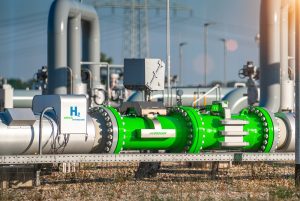The Diplomat author Mercy Kuo regularly engages subject-matter experts, policy practitioners, and strategic thinkers across the globe for their diverse insights into U.S. Asia policy. This conversation with Dr. Nis Grünberg – lead analyst at the Mercator Institute for China Studies in Berlin and co-author of the MERICS report “China’s Nascent Green Hydrogen Sector: How policy, research and business are forging a new industry” (2022) – is the 328th in “The Trans-Pacific View Insight Series.”
China is the world’s largest hydrogen producer. Identify the key factors in China’s development of its green hydrogen sector.
Green hydrogen is promising in two ways: It can decarbonize hard-to-abate industries and serve as a low-carbon energy carrier. China’s enormous hydrogen consumption is today driven by industries such as chemicals and metals, which use vast amounts to produce ammonia, steel, etc. Today 99 percent of this hydrogen is produced using coal and gas, with a significant carbon footprint. If these industries would switch to green hydrogen, it would significantly reduce the CO2 emissions from China’s industries. This, again, requires a massive scale-up of green hydrogen production capacities, and producers of the required technology are expecting a growth market over the next decade.
Medium-term, hydrogen likely will power more commercial vehicles such as trucks, trains, and ships, replacing dirty diesel and bunker engines. This could have a positive side-effect of creating new business for automotive companies, which try to find ways of staying in business in a low-carbon future without combustion engines. This is also the reason China’s large auto sector is pushing hydrogen. If China sticks to the 2030 and 2060 decarbonization targets, green hydrogen will, in other words, very likely be a part of the equation, and that is what is driving policymakers, industries, and research today.
Finally, hydrogen could serve as energy storage for volatile renewables, although this is a more long-term development as it will require advanced new infrastructure to be built for the purpose.
Explain the domestic and global implications of China’s transition to green hydrogen.
If China becomes a green hydrogen leader, the immediate effects would be in decarbonization and technology. Switching to green hydrogen would reduce its CO2 footprint in some of the most polluting industries, which, given China’s size, would lead to measurably lower global emission levels. Chinese companies in, for example, electrolyzer technology would also stand to become a provider of technology needed worldwide for decarbonization. China’s policymakers have identified green tech as a strategic market in which it aims to become competitive. Boosting innovation, and lowering prices by industrial scaling, China could become a leader in hydrogen-related technologies today still dominated by mostly European, U.S., and Japanese firms.
Compare and contrast the hydrogen strategies of China, Germany, the EU, and the United States.
Compared to U.S. and EU strategies, China’s national policy remains conservative regarding green hydrogen. The aim is to first develop hydrogen capabilities more generally, build capacities, invest in R&D, and modernize the existing technology stack. While green hydrogen fits very well with decarbonization and innovation targets, which also are a priority for Beijing, it is not the focus here and now.
The European hydrogen strategy is much more focused on low-carbon hydrogen, as is the U.S. strategy. European approaches are much more ambitious when it comes to the development of green hydrogen capacities and their restrictiveness towards gray and brown hydrogen from coal and gas. China’s national policy only aims to make green hydrogen dominant after 2030, while the EU wants that to happen now.
Where does China stand in hydrogen advanced technologies vis-à-vis the U.S., EU, and Japan?
Depending on the type of technology, China has caught up over the past years. In more advanced electrolyzers, China still has a technology gap of several years. Chinese industry representatives estimate China to be at least five years behind in PEM [polymer electrolyte membrane] and SOEC [solid oxide electrolyzer cell] electrolysis, where especially U.S. and European companies still lead in terms of efficiency and reliability. In alkaline electrolysis, a much older technology, China is already very competitive in price (measured in price per output of H2). If large capacities needed fast will be where the industry moves, it will probably come down to price competitiveness rather than best-in-class, and here China has an advantage. This is not to say that China will not innovate in other tech as well, which, given the investment into R&D is likely. I think the green hydrogen tech market will see more Chinese companies entering the market with increasingly competitive technology over the next decade.
For key trends U.S. and EU policymakers and industry leaders should watch, please refer to the recommendations in the report.

































